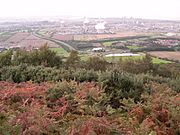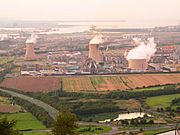Eston Nab facts for kids
Quick facts for kids Eston Nab |
|
|---|---|

Eston Nab from the west
|
|
| Highest point | |
| Elevation | 242 m (794 ft) |
| Listing | (none) |
| Geography | |
| Location | Eston, Redcar and Cleveland, North Yorkshire, England |
| Parent range | Cleveland Hills |
| OS grid | NZ568183 |
| Topo map | OS |
Eston Nab is a famous landmark in north-east England. It is a tall, rocky hill that stands out in the landscape. People who live near the River Tees know it well.
A "nab" means a rocky point or outcrop. Eston Nab is the highest spot on the Eston Hills. It rises 242 metres (794 ft) high. You can see it as a clear sandstone cliff. It looks over the town of Eston. On a clear day, you can even spot it from far away, past Hartlepool.
This special place has a long history. People lived here thousands of years ago. They built Bronze Age burial mounds and an Iron Age hill fort. But for many local people, Eston Nab is most famous for the monument that stands on top. It's a popular spot for families to visit and enjoy the views.
Contents
Discovering Eston Nab's Past
Eston Nab has been important for a very long time. Scientists have found items from the Bronze Age here. These include flint arrowheads. They might be as old as 6,000 to 4,000 BC.
In 1927, a museum expert named Frank Elgee found more clues. He discovered pieces of an old earthenware pot. It was a cremation urn with burnt bone and flint. These items could be from around 1800 BC.
A large Iron Age hill fort once stood at Eston Nab. You can still see parts of its old stone walls and ditches. These were built around 700 BC. Imagine how strong they must have been to last so long!
The Eston Hills, where Eston Nab is the highest point, were once full of ironstone mines. These mines closed in 1949. The iron from these mines helped build the iron and steel industry along the River Tees. This also led to the growth of Middlesbrough. Eston Nab even appeared in a film called A Century in Stone. This movie was about the Eston mines.
In 2014, a group called 'Friends of Eston Hills' bought Eston Nab. This group works to protect the area. One of their members is Craig Hornby, who made the film A Century in Stone. The land they bought includes the area around the monument.
The Famous Monument
The monument you see today is a tall pillar. It is made of sandstone bricks. It was first built around 1800. Its original purpose was a lookout tower and beacon. This was to warn people if an enemy tried to invade during the Napoleonic Wars.
Later, when ironstone mining began, the beacon was used as a house. It stood until 1956. Then it was taken down and rebuilt into the monument we see now.
A special plaque on the monument tells its story:
This monument is placed here to mark the
site of the beacon tower which was erected
by Thomas Jackson of Lackenby about 1800 as
a look-out post against invasion during the
Napoleonic wars and which again served the same
purpose in the second world war of 1939–1945.
It stands within a Bronze Age fortified
camp whose outer defences can be seen.
Erected in 1956.
Nature and Fun at Eston Nab
Eston Nab is 242 metres (794 ft) above sea level. This means it is a "lowland heath" area. It is a great place to see different kinds of plants and animals.
You might spot birds like lapwings, curlews, green woodpeckers, and linnets. There are also many types of butterflies and dragonflies flying around.
The area around Eston Nab is cared for. This helps protect its wildlife and old historical sites. It also makes it a nice place for people to visit. Many people enjoy walking, cycling, and horse riding here. You can find maps for self-guided walks at the Flatts Lane Woodland Country Park Visitor Centre in Normanby. These maps show you interesting spots to see.
The Eston Hills connect to wider countryside paths. Most of the land managed by the Redcar and Cleveland Borough Council is next to farmland. From Eston Nab, you get an amazing view of nearby Roseberry Topping. Roseberry Topping is even taller, at 320 metres (1,050 ft).
Radio Masts at Eston Nab
Eston Nab is also home to digital radio masts for Bauer Teesside. These masts broadcast local radio. They are placed here because it is a high spot.
When these communication towers were first put up, some people were not happy. The monument and the skyline of Eston Nab were a familiar symbol of the area. As part of installing the masts, a road was built to the top of the Nab.
Gallery












